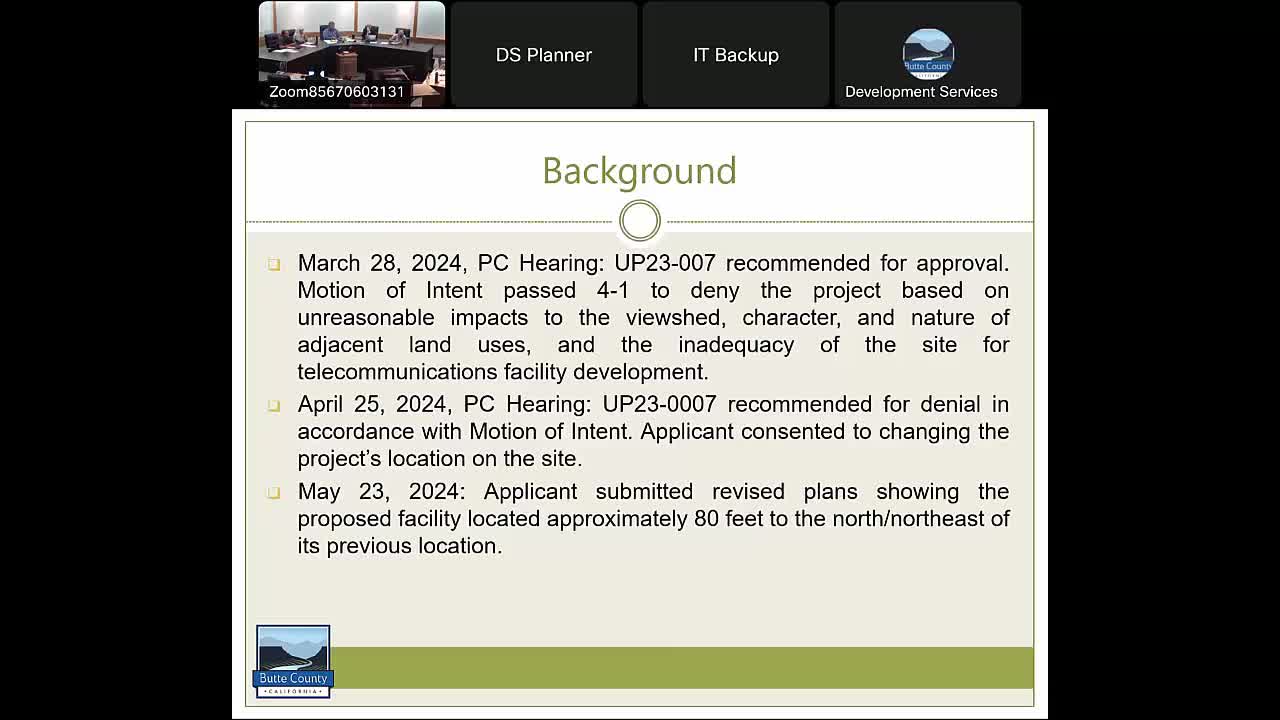Cell tower proposal sparks fierce community debate
June 27, 2024 | Butte County, California

This article was created by AI summarizing key points discussed. AI makes mistakes, so for full details and context, please refer to the video of the full meeting. Please report any errors so we can fix them. Report an error »

In a recent government meeting, discussions centered around a proposed telecommunications facility in Butte County, which includes the construction of a 100-foot monopine tower. The applicant submitted revised plans relocating the tower approximately 80 feet to the north-northeast of its original site, aiming to minimize visual impacts on nearby residences. The facility will feature 10 antennas, remote radio units, and ground equipment, all situated within a 1,600 square foot lease area.
The project has undergone scrutiny regarding its compliance with Federal Communications Commission (FCC) guidelines on radio frequency (RF) emissions. An updated electromagnetic field (EMF) report submitted by the applicant concluded that the operation would adhere to these regulations. The site is not located within any airport compatibility zones or specific overlay zones that would restrict development, and it is zoned for rural residential use.
Despite the applicant's assurances, local residents expressed significant concerns about the tower's proximity to their homes and its potential impact on property values. Public comments highlighted fears regarding visual aesthetics and the adequacy of the site selection process. Critics argued that the project should not proceed without a thorough evaluation of alternative locations, as required by the county's general plan, which discourages cell towers in residential neighborhoods unless no feasible alternatives exist.
The planning commission received a variety of public comments, including objections from residents living closest to the proposed site. They emphasized that the revised location still places the tower in close proximity to their homes, raising concerns about both visual impact and property devaluation. Some residents also questioned the accuracy of the RF emissions report, suggesting that the projected exposure levels might be underestimated.
As the commission deliberates on the project, the outcome remains uncertain, with community members urging a careful consideration of both the potential benefits of improved telecommunications and the preservation of neighborhood integrity. The planning commission is expected to continue discussions and may vote on the proposal in upcoming meetings.
The project has undergone scrutiny regarding its compliance with Federal Communications Commission (FCC) guidelines on radio frequency (RF) emissions. An updated electromagnetic field (EMF) report submitted by the applicant concluded that the operation would adhere to these regulations. The site is not located within any airport compatibility zones or specific overlay zones that would restrict development, and it is zoned for rural residential use.
Despite the applicant's assurances, local residents expressed significant concerns about the tower's proximity to their homes and its potential impact on property values. Public comments highlighted fears regarding visual aesthetics and the adequacy of the site selection process. Critics argued that the project should not proceed without a thorough evaluation of alternative locations, as required by the county's general plan, which discourages cell towers in residential neighborhoods unless no feasible alternatives exist.
The planning commission received a variety of public comments, including objections from residents living closest to the proposed site. They emphasized that the revised location still places the tower in close proximity to their homes, raising concerns about both visual impact and property devaluation. Some residents also questioned the accuracy of the RF emissions report, suggesting that the projected exposure levels might be underestimated.
As the commission deliberates on the project, the outcome remains uncertain, with community members urging a careful consideration of both the potential benefits of improved telecommunications and the preservation of neighborhood integrity. The planning commission is expected to continue discussions and may vote on the proposal in upcoming meetings.
View full meeting
This article is based on a recent meeting—watch the full video and explore the complete transcript for deeper insights into the discussion.
View full meeting
